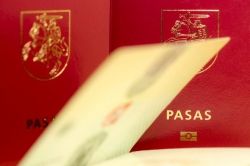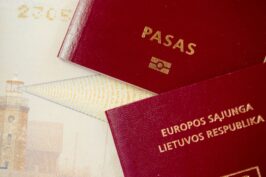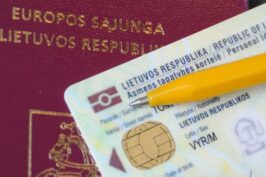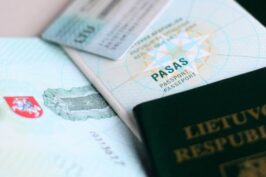- Home
- Lithuanian citizenship in the Vilnius region
Lithuanian citizenship in the Vilnius region
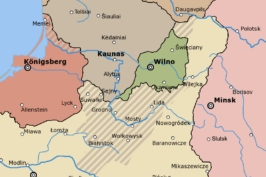
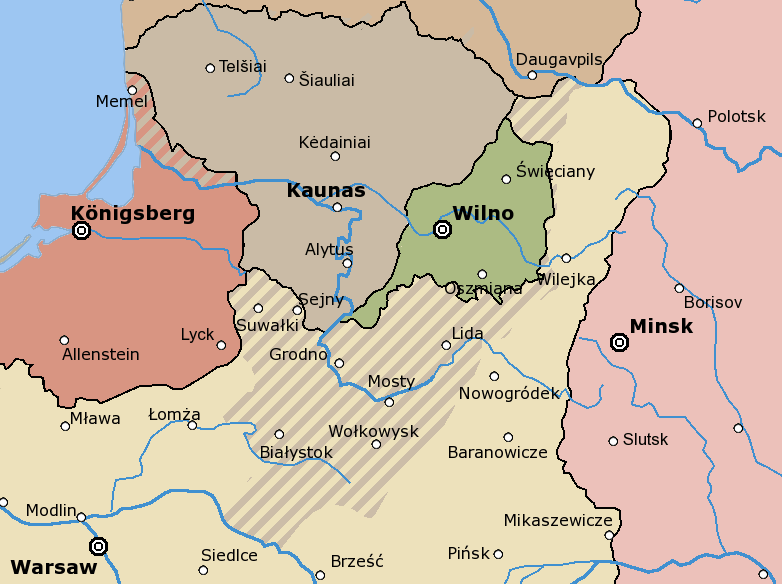
According to 12 July 1920 the Soviet–Lithuanian Peace Treaty, the Vilnius region has been recognized for Lithuania. Since the moment of signing of the Suwalki Treaty, Lithuania has gained legal sovereignty over the region of Vilnius. Residents of the Vilnius region who met the requirements of Article 1 of the Provisional Law on Lithuanian Citizenship and the requirements of Article 6 of the Soviet–Lithuanian Peace Treaty were considered to be citizens of Lithuania.
On 09 October 1920, Poland having broken the Lithuanian-Polish Treaty signed in Suwałki on 07 October 1920, occupied the Vilnius region. This occupation de facto became an annexation.
Having occupied the Vilnius region and started to actually control it, Poland has begun to consider its residents as its citizens and “did not allow them to be seen as citizens of a foreign country”.
The legal situation arose when, basically, Lithuania considered the same people to be Lithuanian citizens, while Poland considered them to be citizens of Poland.
According to 10 October 1939 Agreement on the transmission of Vilnius and Vilnius Region to the Republic of Lithuania and the Soviet–Lithuanian Mutual Assistance Treaty, Vilnius and the Vilnius region were transferred to Lithuania.
Whilst considering the issue of citizenship of the Vilnius region residents, the provision was followed that some of the residents of this region are citizens of Lithuania and the fact of their citizenship of Lithuania is only required to be stated. Lithuanian citizenship is not granted to these persons – after the actual return of the Vilnius region to the composition of the Lithuanian state, residents of this region regained Lithuanian citizenship. Other residents of this region are considered to be citizens of another state or as stateless persons.
Which residents of the Vilnius region are considered to be Lithuanian citizens, was established in the introductory law on the management of Vilnius city and its area adopted on 27 October 1939. Article 3 of this law provided for the following:
The residents of Vilnius city and its area, who on the day of the changeover of the documents of ratification of the Soviet–Lithuanian Peace Treaty on 12 July 1920 were considered to be citizens of Lithuania and on the day of the entry into force of this Law had a place of residence in the city of Vilnius or in its area, shall be considered to be Lithuanian citizens.
The wives of these Lithuanian citizens and their children under the age of 21 are also considered to be citizens of Lithuania; children over the age of 21 of these persons are considered to be Lithuanian citizens, provided they had a place of residence in the city of Vilnius or its area on the day of the entry into force of this Law”.
Therefore, according to the specified law, residents of Vilnius and its area were considered to be citizens of Lithuania, who: 1) in accordance with Article 6 of the Soviet–Lithuanian Peace Treaty of 14 October 1920, were considered to be citizens of Lithuania and 2) on 27 October 1939 had a permanent place of residence in the city of Vilnius or its area.
It should be noted that according to the introductory law mentioned herein, on 27 October 1939 the person should have lived not in that territory of the Vilnius region, which was defined in 12 July 1920 the Soviet–Lithuanian Peace Treaty, but in the “narrower” territory of the Vilnius region, which was established in the agreement signed between Lithuania and Russia on 10 October 1939 and in 1939 October 27 the Supplementary Protocol between the Republic of Lithuania and the Union of Soviet Socialist Republics. “Persons who come from areas not covered by the last agreement with S.S.S.R. not recognized as Lithuanian citizens. The place of permanent residence of a person was considered to be “where one lives due to his/her service, occupation, craft or real estate or has a home farm” (Note 1 of Article 9 of the Passport Statutes).
The residents of Vilnius city and its area were able to prove Lithuanian citizenship by documentation specified in the amendment to Passport Statutes, adopted by the Seimas on 20 November 1939. Such documents included acts of civil status (for example, birth certificates, baptismal certificates, marriage metrics, children’s legalization decisions); documents on recording in the villages, cities or caste communities (for example, books of general population lists, marks on recording into the community in old Russian passports); documents about the time spent in the city of Vilnius or in its area, as well as documents evidencing a permanent residence in the city of Vilnius or in its area on 06 October 1920 and on 27 October 1939.
Citizenship issues of the Vilnius region residents were resolved by issuing passports to them.
On 03 May 1940, the Seimas amended the introductory law on the management of Vilnius city and its area and determined that “Citizens of Lithuania are also those residents of the city of Vilnius and its area who, at any time until 01 August 1914 had a residence in the city of Vilnius and its area, and real estate or work, and who lived in that area for at least five years during the time span from 06 August 1920 to 27 October 1939, if they had a place of residence in that area on 06 August 1920 and on 27 October 1939”.
Therefore, according to the specified amendments to the law, the right to be treated as Lithuanian citizens was acquired by those persons who were related to the Vilnius region until 01 August 1914. They were not required to have been living in Lithuania for at least ten years before 1914, as provided for in Article 6 of the Soviet–Lithuanian Peace Treaty. On the other hand, the law has introduced new additional conditions, for example: the requirement to live in the Vilnius region and on 06 August 1920 and on 27 August 1939, “in other words, during the period of the largest drop in the population due to war, evacuation and call-up.”
On 15 June 1940, the Vilnius region was occupied by Russia.
Citizens of Lithuania according to the Soviet–Lithuanian Peace Treaty of 12 July 1920
The Soviet–Lithuanian Peace Treaty of 12 July 1920 also provided for which persons are recognized as citizens of Lithuania.
Part 1 and 2, Article 6 of the Soviet–Lithuanian Peace Treaty established the following:
“Persons who lived on the territory of Lithuania during the day of ratification of this Treaty and who themselves or their parents permanently lived in Lithuania or were registered in the villages, towns or caste communities in the territory of Lithuania, as well as persons who had been living in Lithuania for at least the last ten years before 1914, having the permanent job there, leaving former civilians and military servicemen, not of the Lithuanian descent, with their families – at the same time recognized as citizens of the state of Lithuania.
Persons of the same category who, during the ratification time of this agreement, lived in the territory of a third country, but have not been naturalized there, were equally recognized as citizens of Lithuania”.
Thus, Article 6 of the Peace Treaty distinguishes four categories of persons who are treated as citizens of Lithuania:
- persons who themselves or their parents permanently lived in Lithuania;
- persons who were recorded in villages, towns or caste communities in the territory of Lithuania;
- persons who have been living in Lithuania for at least the last ten years before 1914 and had the permanent job thereto;
- persons belonging to the abovementioned categories of persons who, when ratifying this Treaty, lived in the territory of a third country and have not acquired citizenship of that state by way of
Persons referred to in Article 6 of the Peace Treaty may have resided either in the territory of Lithuania or in the territory of a third state at the date of ratification of this Treaty.
Persons who lived in the territory of Lithuania were immediately considered to be Lithuanian citizens. Persons who lived in the territory of Russia were considered to be Lithuanian citizens only when they opted for Lithuanian citizenship under the conditions laid down in the Treaty. Persons who lived in the territory of a third state were considered to be Lithuanian citizens only if they were not naturalized in that country.
It should be noted that the Supreme Administrative Court of Lithuania, when investigating the administrative case No A11-421 / 2005 on 19 April 2005 indicated that “the territory of Lithuania (Vilnius region) was occupied by Poland in 1920-1939, therefore, persons lived in it during this period could not objectively be considered Lithuanian citizens and accordingly could not receive documents confirming this citizenship. The specifics of this situation was discussed in the introductory law on the management of Vilnius city and its area (which came into force on 27 October 1939), Article 3 whereof indicated that residents of Vilnius and its area who on the day of the changeover of the documents of ratification of the Soviet–Lithuanian Peace Treaty on 12 July 1920 and on the day of the entry into force of this law, had a place of residence in the city of Vilnius or in its area, are considered to be Lithuanian citizens. According to this article of the law, children of such persons under the age of 21 (on the day of entry into force of the law) were also considered to be Lithuanian citizens. It should be noted that, according to this legal norm, a circumstance is significant whether on the day of the changeover of the documents of ratification of the Soviet–Lithuanian Peace Treaty on 12 July 1920 residents indicated therein may be considered to be citizens of Lithuania. Therefore, when resolving this issue, it is necessary to follow the relevant provision of the Provisional Law on Lithuanian Citizenship (09 January 1919) in force in Lithuania at that time regarding what is considered to be a citizen of Lithuania. According to Article 1 of the latter law, Lithuanian citizens were considered to be persons whose parents and grandparents lived in Lithuania from the old days and who themselves have always been living in Lithuania.
Article 1 of the Provisional Law on Lithuanian Citizenship of 09 January 1919 stipulated that “Citizens of Lithuania shall be: 1) persons whose parents or grandparents lived in Lithuania from the old days and who themselves have always been living in Lithuania; 2) children of persons indicated in section 1 who, even though did not always live in Lithuania, but returned to live there; 3) persons who have lived in Lithuania for at least ten years before 1914 and who had: a) their own real estate, b) or permannet job; 4) children of the Lithuanian citizen; 5) his wife or widow; 6) children of unmarried Lithuanian citizen, provided they were not accepted by a foreigner as his children; 7) foreigners newly accepted as Lithuanian citizens”.
The amendment to Article 3 of the introductory law on the management of Vilnius city and its area adopted on 03 May 1940 stipulates that “Citizens of Lithuania are also those residents of the city of Vilnius and its area who, at any time until 01 August 1914 had a residence in the city of Vilnius and its area, and real estate or work, and who lived in that area for at least five years during the time span from 06 August 1920 to 27 October 1939, if they had a place of residence in that area on 06 August 1920 and on 27 October 1939”.
MIGRATION LAW CENTER
